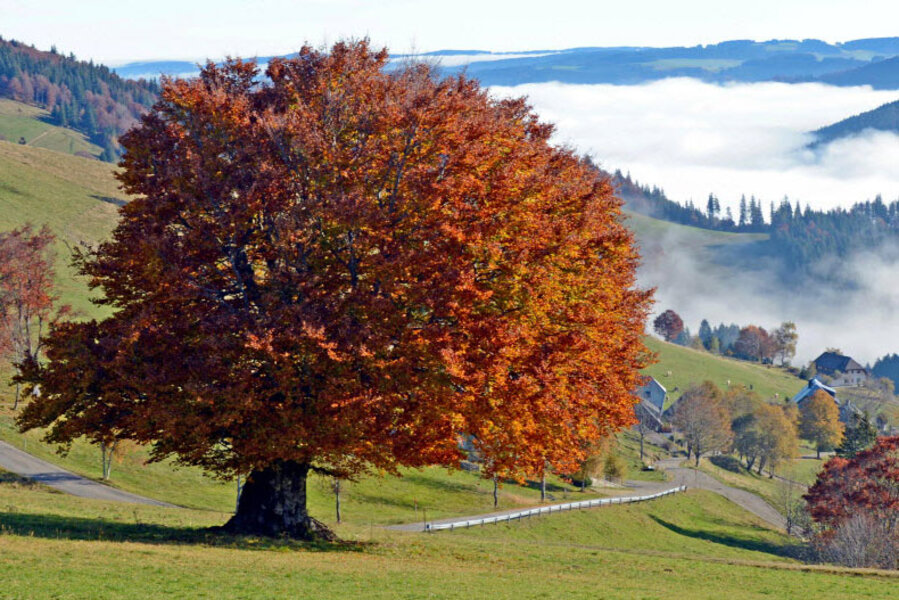Peculiar behavior of European trees raises climate change questions
Loading...
A key sign of global warming's effects on forests – timing of the first leaves in spring – has taken an unexpected turn in recent years, according to a new study.
The results point to the vulnerability of broad-leaf forests to warming in their current ranges. They also may guide improvements to the models ecologists use to anticipate the changes global warming is expected to bring to forests, researchers say.
A warming climate lengthens the growing season. One sign that the season is becoming longer appears as changes to the dates the first leaves appear on trees and shrubs. Generally, the pace of earlier leaf-out has been tracking the rate of warming, as expected.
But in central Europe, a large number of ash, beech, chestnut, oak, and other deciduous trees have begun behaving differently, the new study finds.
While leaf-out times continue to arrive earlier with warming, the march toward earlier leaf-out has slowed unexpectedly and significantly – on average by 40 percent – since the turn of the millennium, despite continued warming.
The impact of lengthening growing seasons on forest vegetation needs further study, researchers say. This study could add a piece to a very incomplete puzzle.
Yet to some scientists, it suggests that the trees in the study may be hinting at a slow ecological overhaul in the region.
Deciduous trees "don't have the ability to not be dormant" in winter, says Jason Fridley, an ecologist at Syracuse University. They have a limited ability to respond to longer seasons.
"The fact that the timing of spring bud-break is slowing down is one indication among many that eventually the growing season will be so long that plants that have this enforced dormancy will not be the ones that win out in competition" for turf under a warmer climate, he says.
Evergreens in the Mediterranean are waiting for the right climatic cues to march north to take over. Those evergreens "are perfectly happy being evergreen and taking advantage of January weather, if it gets warm enough, to out-compete" the deciduous trees, says Dr. Fridley, who was not involved in the study.
Changes in the timing of the appearance and the loss of leaves can affect regional and perhaps global climate. And if different types of vegetation move in, that can have an effect, too. For example, such changes affect the average amount of sunlight a region reflects back to space, moisture levels and wind behavior, and the uptake of carbon dioxide from the atmosphere. When leaves appear earlier, a tree is able to take up more CO2.
Models that try to predict these effects are predicated in part on the notion that the pace of changes in the timing of leaf-out and leaf loss track rising temperatures.
These new results suggest that trees may not leaf out as early as models indicate, notes Trevor Keenan, an ecologist at Macquarie University in Sydney, Australia, in a commentary that accompanies a formal description of the findings in Thursday's issue of the journal Nature.
The team reporting the results notes that lab experiments with twigs or saplings have hinted at the slowdown with rising temperatures. But no one has found evidence for it in the field, particularly among adult trees.
The team turned to seasonal tree-behavior records spanning 33 years for seven species of deciduous trees at more than 1,200 sites in central Europe, mainly in Germany.
The team found that between 1980 and 1994, leaf-out was averaging 4 days earlier for each 1 degree Celsius (0.6 degrees Fahrenheit) of warming. Between 1999 and 2013, the pace slowed to 2.3 days per degree Celsius, a 40 percent decline.
The researchers then tested three possible explanations for the change. The explanation that seemed most plausible involved warmer temperatures during the dormant season. Typically, the trees need a certain number of chilly days in winter to leaf out at a given temperature, the team explains. The fewer chilly days in winter, the warmer it has to be for leaves to appear the following spring.
But the fundamental cause remains to be uncovered, Dr. Keenan writes. And more work needs to be done to see how the extensive the phenomenon is; the hunt for evidence needs to expand to more species in more locations. And the study only focuses on the beginning of the growing season.
Still, the results are solid, Fridley adds.
"No one particular test is a silver bullet in demonstrating what they wanted to show," Fridley says. "But they do so many tests and change their assumptions in so many ways that as a whole, it's pretty convincing."








